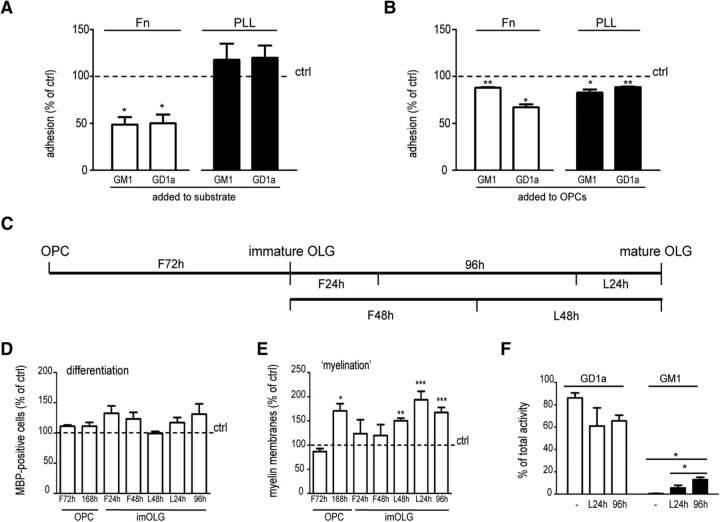Figure 5.
GD1a becomes effective in overcoming fibronectin-mediated inhibition of myelin membrane formation at a relatively late stage of OLG maturation. A, OPCs were plated on plasma Fn- or PLL-coated 96-well plates that were pretreated with vehicle (ethanol, ctrl) or the indicated gangliosides (10 μm). OPCs were allowed to adhere for 1 h, after which the relative percentage of adherent cells was determined using a colorimetric assay. The horizontal line represents adherence to vehicle-treated substrates, which was set at 100% in each independent experiment. The percentage adherence of OPCs on vehicle-treated PLL and Fn was 66.5 ± 7.3% and 50.8 ± 4.4%, respectively. Statistical differences with OPCs cultured on the respective vehicle-treated substrate, as assessed with a one-sample t test, are indicated (Fn, *p < 0.05, n = 3). Note that GD1a and GM1 pretreatment of Fn, but not of PLL, decreases the adhesion of compared with adhesion on vehicle-treated substrate. B, Freshly isolated OPCs were pretreated for 30 min with vehicle (ethanol, ctrl) or the indicated gangliosides (10 μm), plated on Fn- or PLL-coated 96-well plates, and subjected to an adhesion assay (A, *p < 0.05, **p < 0.01, n = 3). C, Schematic representation of the treatments indicated in D and E. Upon differentiation of OPCs cultured on Fn, cells were continuously or transiently exposed to GD1a at the indicated differentiation stage and duration. MBP immunocytochemistry was performed at the mature OLG stage for all conditions. h = h. D, E, The number of MBP-positive cells (differentiation, D) and the number of MBP-positive cells bearing myelin membranes (“myelination,” E) were assessed. Each bar represents the mean ± SD of three independent experiments. In each experiment, the data of vehicle-treated cells was set at 100% (horizontal line). The mean percentages of MBP-positive cells and MBP-positive cells bearing myelin membranes in vehicle-treated cells were 44.6 ± 6.9% and 20.2 ± 6.5%, respectively. Statistical differences with vehicle-treated cells cultured as assessed with a one-sample t test, are indicated (*p < 0.05, **p < 0.01, ***p < 0.001, n ≥ 3). Note that ganglioside GD1a overcomes Fn-mediated inhibition when present at late differentiation. F, Immature OLGs and OLGs cultured on Fn at 6 d after initiating differentiation were treated with [3H]-GD1a for 96 and 24 h, respectively. Total gangliosides were extracted and separated by TLC, and the percentage of total activity determined. “0 h” is [3H]-GD1a that was not exposed to cells. Each bar represents the mean ± SD of three independent experiments. Statistical analysis as assessed with a one-way ANOVA are indicated (Newman–Keuls post-test, *p < 0.05, n = 3).

